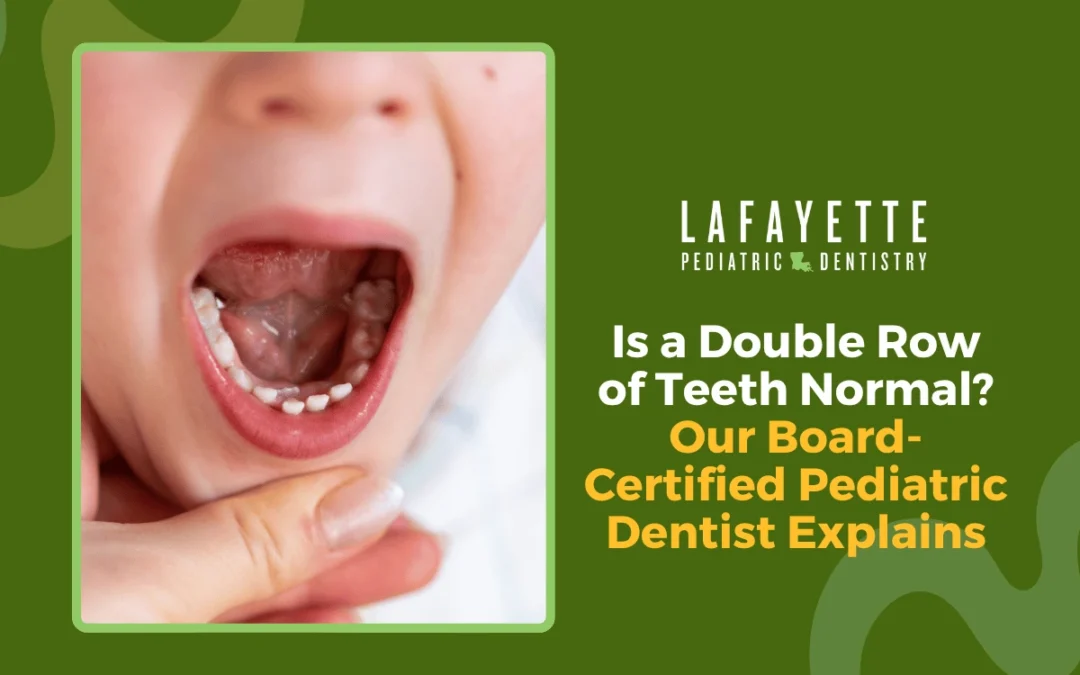You’re brushing your kid’s teeth one night and suddenly you spot a second row of teeth popping up behind the baby ones. Is that… normal?
It might look odd, but this is actually a really common thing we see in children. It’s called having a “double row of teeth,” and most of the time it’s not a cause for panic. Our board-certified pediatric dentist, Dr. Gouri, explains what’s really going on and when it’s time to give us a call.
What Does a “Double Row of Teeth” Mean?
What parents are usually describing is something we call “shark teeth.” And it’s a pretty fitting name because it looks exactly like what you’d imagine: two rows of teeth, one behind the other, kind of like a shark’s mouth.
Here’s what’s actually happening: your child’s permanent teeth are starting to erupt, but instead of coming up directly underneath the baby teeth like they’re supposed to, they’re coming in behind them.
The baby teeth are still hanging on, so you end up with this double-row effect. It’s usually temporary, but it can look a bit unsettling when you first spot it.
Should Your Child See a Dentist About Shark Teeth in Kids?
This isn’t a dental emergency, so you don’t need to rush to the emergency room. But you should schedule a visit with your child’s dentist so we can take a look at the situation and figure out the best course of action.
In some cases, we might need to extract the baby tooth. If that baby tooth is really stubborn and showing no signs of loosening, it could be blocking the permanent tooth from moving into its proper position. Removing the baby tooth will give the permanent one room to shift forward where it belongs.
But in other cases, if the baby tooth has already started to wiggle, we might just take a wait-and-see approach. Sometimes nature takes its course and the baby tooth falls out on its own within a week or two.
Once it’s gone, the permanent tooth often shifts forward into the correct spot without any intervention needed. Your child’s tongue naturally pushes against their teeth, which can help guide that new tooth into place.
But there are also other factors we look at, like your child’s overall tooth structure, how much space they have in their mouth, and whether there are any other alignment concerns. Some kids have narrower jaws, some have larger teeth, and all of that can affect how we approach the situation.
Since every child is different (even siblings can have totally different experiences with losing teeth), it’s best to talk with your pediatric dentist. What works for one kid might not be the right move for another.
Read more: Understanding Your Child’s Irregular Tooth Growth: Advice from Our Dental Experts
Can You Prevent Shark Teeth in Kids from Happening?
The short answer? Not really. Shark teeth are mostly just not preventable. It’s one of those things that can happen to any child, regardless of how well you’re taking care of their teeth at home.
That said, regular dental checkups starting at age 1 are still super important. Early and consistent monitoring helps us spot potential issues before they turn into bigger problems.
When we’re seeing your child regularly, we can track how their teeth are developing, watch for signs that permanent teeth are getting ready to come in, and give you a heads up about what to expect.
These routine visits also help your child get comfortable with the dentist, which makes any necessary treatment down the road much easier for everyone involved. Prevention and early intervention are always the best course of action when it comes to your child’s oral health.
At our practice, we serve families in the greater Acadiana area, including Lafayette, Youngsville, Breaux Bridge, Carencro, and Broussard. We’re here to help guide your little one through all the stages of dental development, from that very first tooth and beyond. Reach out to our team to book an appointment or learn how we can support you and your child!
